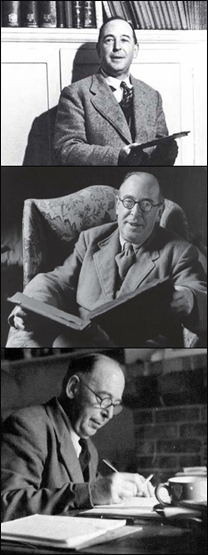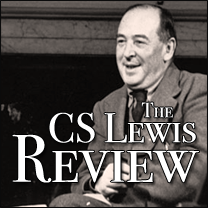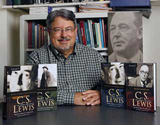
Lewis's Grand Miracles: Against Naturalism
April 5th, 2008 | Skip to comments
Miracles (1947) is comprised of seventeen lucid and succinct chapters and two appendices crafted with Lewis’s characteristic care for precision of definition, ample and multiple illustration of key points, and the anticipation and critique of objections from earnest readers.
In view of such works as Al Gore’s The Assault on Reason (2007) and Susan Jacoby’s newly published, The Age of American Unreason, Lewis offers a salutary, if anachronistic (used positively here!) counterpoint to much confusion about the role of reason, evidence, faith, and “facts” in determining the true nature of reality.
A richly diverse, self-consciously “philosophical” work difficult to capture in a paraphrase, Miracles clearly draws upon the assumptions about the value and limitations of reason and the validity of natural law that Lewis had employed broadly in his autobiographical allegory, The Pilgrim’s Regress (1933), and explicitly in later apologetical writings such as The Problem of Pain (1940), Broadcast Talks (1942) (published as part of Mere Christianity in 1952), The Screwtape Letters (1942), and The Abolition of Man (1943).
Here Lewis offers a thoroughgoing defense of supernaturalism as a rational option for post- and anti-modern thinkers, explaining the place of miracles within such a belief system. One’s belief that miracles may occur does not obligate the believer to accept any and all claims of the miraculous as fact; it merely invites the inquiry into the nature and credibility of the claim, which must be decided on reasoned criteria.
Lewis’s case for the miraculous is accompanied by a vigorous refutation of naturalism as ultimately an illogical, self-defeating worldview which fails to account even for the validity of its own reasoning process; it is the quasi-religion of a “chronologically snobbish” age rather than a convincing alternative to theism.
In later chapters, Lewis champions Christianity as a supernatural faith whose power depends upon the historical veracity of its miracles as depicted in the New Testament: chiefly its “Grand Miracle,” the Incarnation of Christ, which is, if true, “the central event in the history of the Earth–the very thing that the whole story has been about.”He is the Fact which cannot be explained away, and from which all Facthood descends.
Having subtitled his work “a preliminary study,” Lewis begins Miracles with an epigraph from Aristotle, “Those who wish to succeed must ask the right preliminary questions,” which in this case are two: “are miracles possible, and, if so, are they probable?” Lewis’s specific goal is to answer these “philosophical questions” as a necessary first step in equipping his readers to go on to examine with integrity the miracles of the Bible on their own merits.
To do so, he must remove numerous “red herrings” the modern world places in the path of otherwise objective readers, and Lewis spends his first ten chapters in this endeavor. Those whose philosophies constrain them by definition from entertaining even the possibility of miracles are, Lewis says, “wasting their time” by looking into the New Testament texts that record the miraculous; their “question-begging” will only return them the negative answers determined before they start.
Lewis carefully defines miracle as “an interference with Nature by supernatural power,” and quickly makes a distinction between two kinds of thinkers: the Naturalist who believes that nothing exists “except Nature,” and the Supernaturalist, who believes that “besides Nature, there exists something else.”
The Naturalist tends to think that Nature is “everything” or “the whole show” or “whatever there is,” and envisions a universe of interlocking things and events that permit no serendipity, spontaneity, or independent action–“a vast process of space and time which is going on of its own accord .” The “system,” if well-described and understood, can account for all circumstances that exist or ever will. As an article of “faith,” naturalism excludes the miraculous.
In contrast, the Supernaturalist believes in a hierarchy of order and being, an “open universe” which may allow for reality to encompass all manner of surprises, mysteries, and discontinuities–including the intervention of a Divine Being seeking to accomplish his purposes. Whereas the Naturalist believes in “One Thing,” i.e., Nature and its components within a Total System, the Supernaturalist believes in One Self-existent Thing and a class of items derived from that “One Thing” that bear distinct personal relationships to it, thus making room for a Creator God, and a creation that reflects his image and is subject to his will.
In his controversial third chapter, entitled, “The Self-Contradiction of the Naturalist,” Lewis boldly declares that consistent Naturalism is, in fact, self-refuting, for if it is true, “every finite thing or event must be (in principle) explicable in terms of the Total System,” and thus even Reason itself is suspect, arising as it does as an artifact of inexorable, non-rational causes. Reason must be subject to the same fatalistic explanation as that of other phenomena, which therefore guarantees us no independent agency by which we can validate the theory of Naturalism itself.
Naturalism, Lewis avers, represents “a proof that there are no such things as proofs–which is nonsense.” His philosophical statement of this “rule” is that “no thought is valid if it can be fully explained as the result of irrational causes.” As Richard Purtill explains Lewis’s argument, “If mind is only a chance product of nature, how can we trust our reasoning powers, how can we expect our minds to give us the truth about anything?”
During a celebrated exchange in February, 1948, at Oxford’s Socratic Club, an undergraduate organization which Lewis helped found for the purpose of religious debates, Catholic philosopher Elizabeth Anscombe challenged the cogency of this particular attack on Naturalism.
Anscombe, herself a committed believer who later became a professor of philosopher at Cambridge, argued that at best Lewis overstated his case, and at worst seriously misunderstood the differences in philosophical argumentation between “cause and effect” and “ground and consequent. (One result of Anscombe’s rebuttal was Lewis’s revision of chapter three of Miracles when Fontana, a British publisher, brought out a paperback version in 1960. Lewis retitled the chapter, “The Cardinal Difficulty of the Naturalist.”)
Having established the broad grounds for his argument, Lewis proceeds systematically to build a case for the superiority of supernaturalism, which can account for both Reason and Nature. If Nature cannot logically produce Reason, it is more probable to posit an order of being in which Reason or, theistically speaking, a Divine Mind is self-existent and each human mind “an off-shoot . . . or incursion of that Supernatural reality into Nature.”
Hence, God’s creation of nature is a more reasonable doctrine and more probable event than the prospect that Nature by chance produced Mind. There is no logical contradiction in believing that Nature is an orderly system governed by Reason and in also believing that the God Who is Reason may intervene by his power to alter the course of natural events for his purposes: “In science we have been reading only the notes to a poem; in Christianity we find the poem itself.”
Lewis’s concluding chapters on the incarnation and the miracles of the old and new creation and offer stirring expositions of the kinds and quality of miracles presented in the New Testament and rank among Lewis’s most lucid and inspiring theological reflections.
Miracles is, in essence, Lewis’s last sustained work of apologetics, and save occasional, usually solicited, essays on specific topics; for the rest of his career Lewis turned almost exclusively to writing fiction (The Chronicles of Narnia , 1950-56; Till We Have Faces, 1956), memoir (Surprised by Joy , 1955), biblical exposition and theology (Reflections on the Psalms, 1958; The Four Loves, 1960), and devotional literature (Letters to Malcolm , 1964).
While some biographers have argued that Lewis’s 1948 debate with Elizabeth Anscombe was a watershed moment in his career, shaking his confidence in his ability to write effective apologetics, a more balanced account would suggest that he simply had entered a stage in his life in which Reason had given him all that it had to convey about Christianity, and it was now time for Lewis to trust his Imagination to complete his vocation before God.
For more on Lewis’s debate with Anscombe and the biocritical response to it, consult Victor Reppert’s C. S. Lewis’s Dangerous Idea (IVP, 2003), and his ongoing treatment of these and other philosophical issues on his sprightly written blog.




Comments
No comments yet.
RSS feed for comments on this post.
Sorry, the comment form is closed at this time.